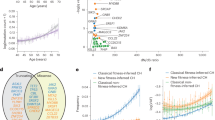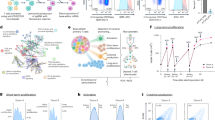Abstract
Genomic instability is one mechanism proposed to play a role in the disease progression of chronic myeloid leukemia (CML). Microsatellite regions in the type II transforming growth factor-βreceptor (TGF-βRII) gene appear to be targets for mutation in some cancers displaying microsatellite instability (replication error phenotype, RER+). Furthermore, TGF-βRII mutations in RER+ tumors have been associated with decreased TGF-βRII mRNA levels. As TGF-βis a potent negative growth regulator of hematopoietic cells, investigations were undertaken to determine whether inactivation of the receptor by microsatellite alteration might be involved in the progression of CML. Analysis of TGF-βRII mRNA expression by RNase protection, with comparison of cells from the chronic, accelerated and blast phases of CML, showed no change in TGF-βRII transcript levels during disease progression. However, during each phase of the disease, low levels of TGF-βRII were detected when compared with the hematopoietic cells of normal donors. Furthermore, this decreased expression was also observed in the other myeloproliferative disorders, polycythemia rubra vera (PRV) and essential thrombocythemia (ET). The leukemia cell lines K562 and HL-60 had no detectable TGF-βRII mRNA. Two microsatellite regions found altered in RER+ colon cancers were analyzed to establish if these sequences were aberrant in CML. No alteration was detected in either of these regions in any phase of the disease. These results suggest that alterations of the microsatellite regions in the TGF-βRII gene are not involved in the progression of CML. Decreased expression of TGF-βRII in CML cells and leukemia cell lines raises the possibility that altered expression of the receptor may play a role in the initiation and/or maintenance of the disease state.
This is a preview of subscription content, access via your institution
Access options
Subscribe to this journal
Receive 12 print issues and online access
$259.00 per year
only $21.58 per issue
Buy this article
- Purchase on Springer Link
- Instant access to full article PDF
Prices may be subject to local taxes which are calculated during checkout
Similar content being viewed by others
Author information
Authors and Affiliations
Rights and permissions
About this article
Cite this article
Rooke, H., Vitas, M., Crosier, P. et al. The TGF-β type II receptor in chronic myeloid leukemia: analysis of microsatellite regions and gene expression. Leukemia 13, 535–541 (1999). https://doi.org/10.1038/sj.leu.2401384
Received:
Accepted:
Published:
Issue Date:
DOI: https://doi.org/10.1038/sj.leu.2401384
Keywords
This article is cited by
-
TGFβ/BMP inhibits the bone marrow transformation capability of Hoxa9 by repressing its DNA-binding ability
The EMBO Journal (2006)
-
Autocrine transforming growth factor-β regulation of hematopoiesis: many outcomes that depend on the context
Oncogene (2005)
-
Transforming growth factor-β signaling in normal and malignant hematopoiesis
Leukemia (2003)
-
Basic sciences of the myeloproliferative diseases: Pathogenic mechanisms of ET and PV
International Journal of Hematology (2002)



